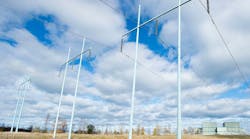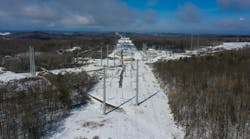For an updated look at the report with diagrams, see EPRI final report.
The nation’s grid system was largely unaffected as a huge, 2-day solar storm pummeled Earth starting March 8 with a massive blast of plasma that was ejected from the sun at as much as 4 million miles per hour. At its peak the flare activity was the most intense solar event since 2006. No power disruptions were reported from the storm that rapidly dissipated on March 9.
While the Electric Power Research Institute research team continues to see activity, it made sense to provide the highlights of this event thus far. The Electric Power Research Institute (EPRI) measures geomagnetically induced currents (GIC) through its SUNBURST program, a system of strategically positioned monitoring sites throughout the United States and Canada. It uses data from that system, to provide guidance to utilities on keeping the power delivery system functioning during solar storms and to provide feedback to those developing GIC models and forecasting tools. In the future, models of the power system, designed to evaluate the flow of GIC could be included to enhance the capability of the system.
SUNBURST GIC Activity Summary, March 7-9, 2012
The SUNBURST monitoring system recorded several periods of minor and moderate level GIC between the early morning hours of March 7, 2012, and mid-day on March 9, 2012. This GIC activity was the result of several solar flares from the same active sunspot region on the sun, and it can be broken down into three separate periods of activity with relative calm between.
It should be noted that the GICs recorded during these periods of activity are still quite small relative to the larger storms recorded during the previous solar cycle. During that cycle, SUNBURST recorded several severe events with multiple sites experiencing GICs in excess of 100A.
March 7, 2012
The start of GIC activity coincided with the arrival of a CME at 04:27 UT. For low-level events, the sudden impulse—which signals the start of activity—sometimes produces the largest GICs during an event. This was not the case for this event. The maximum GICs occurred several hours later. This activity lasted for approximately 12 hours.
For this first period of activity, only the Grand Rapids site in Manitoba experienced neutral dc currents in excess of 10A. The peak GIC recorded at this site was 21.9 A, which was also the largest GIC recorded over the entire 3 day period.
The following table lists the neutral current levels by site for March 7, 2012. Only sites that experienced significant GIC levels are included.
Central Hudson - Pleasant Valley: -7.0A to 7.4A
Central Hudson - Hurley Ave.: -9.1 to 6.3A
CMP/BHE - Chester: -4.1A to 6.0A
Manitoba Hydro - Grand Rapids: -21.9A to 9.6A
Con Edison of NY - Goethals: -6.1A to 7.3A
TVA - Paradise: -6.4 to 6.3A
In addition, Jim Kleitsch at ATC reported that one of their sites experienced neutral dc currents in excess of 10A.

